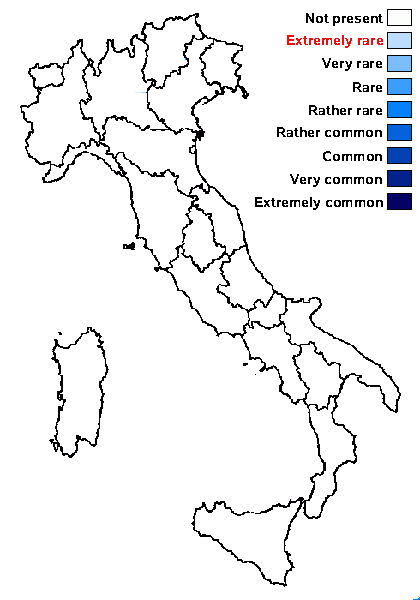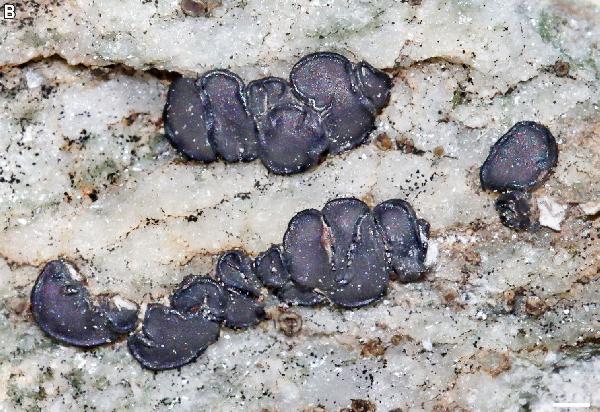Sarcogyne poeltii K. Knudsen, Obermayer, Hodková & Kocourk.
in Knudsen & al., Herzogia 36, 2: 463, 2023.
Synonyms:
Distribution:
Description: Thallus crustose, endosubstratic, not evident, with scattered algal cells in the rock. Apothecia lecideine, usually round, 0.2-1.5(-2) mm across, broadly attached, replicating by division, with a black (red when wet), flat to slightly convex, epruinose disc and a black, usually raised, smooth, persistent proper margin. Proper exciple c. 100 µm wide, the hyphae usually not visible, the outer carbonized layer black, c. 20 µm thick, the inner layer reddish near the hymenium, with crystals of psoromic acid visible under polarized light; epithecium reddish brown, c. 10 µm high, sometimes with crystals of psoromic acid; hymenium colourless, 80-100 µm high, the hymenial gel hemiamyloid, K/I+ light blue fading to light red; paraphyses 1-2 µm thick at mid-level, the apical cells barely expanded; subhymenium 15-40 µm high, euamyloid, IKI+ blue; hypothecium 300-400 µm high, of radiating, c. 1 µm thick hyphae, with abundant crystals of psoromic acid. Asci >100-spored, clavate, strongly thickened at apex, 40-80 x 20-25 µm. Ascospores 1-celled, hyaline, narrowly ellipsoid, 4.5-6.5 x 1.5-2 µm. Pycnidia abundant, epilithic, in black, spherical, sessile stromata not producing psoromic acid. Conidia ellipsoid to globose, 2-3 x 1-2 μm. Photobiont chlorococcoid. Spot tests: thallus K-, C-, KC-, P-; sections of apothecia (margin, epi-and hypothecium) P+ yellow. Chemistry: psoromic acid in the apotheciaNote: this silicicolous species is one of the few Acarosporaceae which produce psoromic acid in the apothecia; formerly treated as S. similis H. Magn., which is an American species, it is known only from the type collection in Greece, on granite. Its presence in Italy cannot be excluded.
Growth form: Crustose
Substrata: rocks
Photobiont: green algae other than Trentepohlia
Reproductive strategy: mainly sexual

Predictive model
Growth form: Crustose
Substrata: rocks
Photobiont: green algae other than Trentepohlia
Reproductive strategy: mainly sexual

Predictive model


